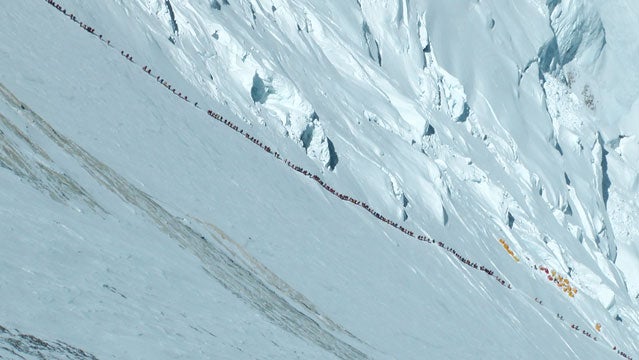It was the image that embodied a disastrous year on Everest: A traffic jam of climbers jockeying for position at the top of the world. Since taking the photo in 2012, German mountaineer Ralf Dujmovits has kept a low profile. Dujmovits, who is married to climber Gerlinde Kaltenbrunner, has been guiding a trekking group in South America; climbing in the Alps; traveling to Vietnam and Laos for rock and sport climbing; hitting up Smith Rock, Oregon; and ski touring in Norway. Now, with the action on Everest heating up, we checked in with Dujmovits for a preview of what we can expect this May, and for an inside take on his breathtaking photo.
Last May, you turned back on your bid to summit Everest without supplemental oxygen but came away with the year’s most iconic photo. What happened?
Ueli Steck and I had started toward the summit, but the antibiotics I was taking for sinusitus made me feel awful. So I waited a few hours before packing my things [to head down].
I came down the Geneva Spur, and already at the Yellow Band there were lots of people. And underneath the traverse to Camp III, it was just a black line, a long black line. I almost couldn’t believe what I saw, that so many people made the decision at the same time to go up.
Did you think that any of the climbers were in danger?
I was very sure at that moment that some of them wouldn’t make it back. It’s just a question of statistics. As I know the Summit Ridge, I know the Hillary Step—I had been in ’92 on the Summit with oxygen—I just know that there is not enough space for everybody.
Are you disappointed that you turned back that day?
I feel privileged to have made the decision to turn back and take this picture. Of course, in the beginning, when I decided to turn back on my fourth time trying to climb Everest without oxygen, I was disappointed and sad. But then when I came to the Lhotse face and saw this huge queue, at first I couldn’t believe it. I witnessed something that hopefully can be a landmark in Everest climbing, that people can start understanding that these queues are just killing the climbers. The more people queuing up, the fewer making it back.
Did you have hopes that your photo would change how people climb Everest?
My deep hope was that the number of climbers on Everest would be reduced. But I fear that I’ve made Everest more popular with this picture. People may start thinking, If there are so many people, I can also queue up. It was my hope to make more people understand that this has nothing to do with mountaineering, that it's a trophy hunt. But I don't think people got the message.
At the time, did you realize the power of your image?
The media frenzy was a surprise. Perhaps the air was too thin. I was tired after having carried all my gear up, and I was disappointed.
Were you concerned that the image would sensationalize Everest?
I had hoped the opposite: that people will understand there is no adventure on Everest anymore, there is no climbing, that everybody has to queue up.
It's funny, I bet 99 percent of these climbers wouldn’t queue up in a five-meter queue in a bakery, but they queue up in a several-hundred-meter-long line to get something that doesn’t exist any longer. I had hoped people would realize that, but I fear most didn’t. It was just another shocking picture.
What do you mean by there being no adventure left?
Being on Everest on the Tibetan normal route, people get no feeling for what it means to be on a lonely route, on an eight thousand meter peak, on your own, without all these crowds. The climbers on Everest are trying to achieve something that doesn’t exist any longer—at least on Everest.
Last year, you called for stricter regulations on Everest. Do you still think the Nepalese government should start strictly regulating who can set foot on the mountain?
After the expedition, I asked them: Please, you should introduce new regulations, you have to look at the climbing background of the people—what they have climbed before. Everbody who attempts Everest should have climbed another eight-thousand-meter peak before.
But I've come to realize that won't change. The Nepalese government makes money from Everest. Like the Saudis sell their oil, they’re trying to sell the mountain. This has to be understood by the climbers themselves. Later on, when I saw my photo go around the world, my hope was not to have the need for more regulations, but to make prospective climbers better understand where they are going to.
Given everything you’ve seen, will you make it back to Everest?
Directly after the climb, I said, never again. But it’s the only peak of the world's 14 tallest that I haven't climbed without using supplemental oxygen. It’s not a question of if I will go, but which route I will go.
What can we expect this year—will there be even more climbers running into trouble?
I don't want to know. I fear it’s worse than before.
Do you have any advice for someone looking to summit?
If somebody has a deep desire to go to Everest, he should go. On the normal routes with lots of people, it’s dangerous. Anyone who goes should be very, very fit to be among the quicker sheep. Otherwise, there’s a good chance of dying.
With the Himalayan climbing season underway, we look back on some of the most stunning images from 2012.
There is still adventure left on Everest, and it's on the West Ridge. In a story unlike any other we've ever told, we explore the 1963 West Ridge Expedition: Lost on Everest.


